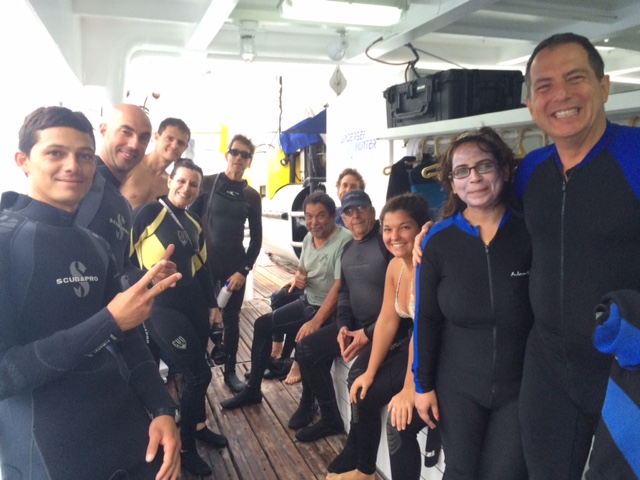(Editor’s Note: This is the third post in a series of blog posts about the Feb. Cocos Island Expedition to track sea turtles and sharks in order to create a protected science-based swimway that will safeguard endangered marine wildlife during their migrations in the Eastern Tropical Pacific. You can read the first blog here. See the entire series here).
Friday, February 13, 2015
I woke up at 5 am to film our dive boats being loaded into the water with a massive crane from the back of our mother ship – Argo. The Undersea Hunter crew made incredibly quick work of the operation and by 7 am everything was set and ready to go for us to embark our first day of diving.
Jim, the cruise master of the ship, divided us up into two dive teams – Yellow and Blue. Thus allowing us all to dive in small groups. I am on team yellow, which is clearly the best team to be on, as it is led by Dive Master Brayan, and made up of:
- My boss Todd Steiner, an expert turtle catcher;
- Mark Stabb, an engineer and also a crucial part of the turtle; catching/shark tagging team;
- Pooja, a repeat Cocos Island participant who helps replace acoustic receivers and LOVES sharks;
- Andreas, an expert diver from Germany who has traveled to Cocos nearly 30 times;
- Lucas who runs DWS Diving in Italy and is a dive master himself;
- Laurent from France who is a talented underwater photographer and married to the beautiful Nada from Lebanon; and
- Lohana who is helping Todd keep track of the number of shark species we see on our dives

The Yellow Team (Back Row: Andreas, Todd, Mark. Middle Row: Lohana and Joanna. Front Row: Luca and Brayan).
For our first dive we head to Chatham Bay. Brayan calls the yellow team over and walks us through the dive plan for this check out dive. I’m nervous because much of this is new to me and honestly I’m the least experienced of the group, but the only way to get over the first day jitters is to take a breath of air, kick your flippers up and plunge into the blue waters of Cocos Island.
Chatham Bay is a beautiful sandy bottom spot teaming with marine life – from white tip sharks resting on the bottom to large tunas dancing above the coral and of course … eels!
After the check out dive, everyone makes the necessary adjustments and before you know it we are ready to go on our second dive of the day in Manuelita Channel.
Manuelita is the picturesque Island that Argo (our boat) is resting behind. The island from above ground is an important habitat for blue and red footed boobies, and beneath the Island lies a series of cleaning stations for Hammerhead Sharks. Barberfish (a type of beautiful yellow and black angel fish) will swim up and eat parasites off the sharks.
We drop down one at a time and wait at around 15 meters for everyone to join the group and then make our way down looking around for hammerheads. We see white tip sharks, a black tip shark, and a burrito grunt fish (I love burritos so this is already one of my favorite fish).
We follow Brayan our dive master who has a bright yellow tank and is easy to spot underwater through the oasis around Manuelita for this, and our third dive of the day, but are not visited by any hammerhead sharks. However we do see many beautiful mobula rays, which we count and record as part of our scientific efforts to monitor shark and ray species in the area.
Read our Day 4 blog here. See the entire blog series here.
Learn more about our Cocos Island Expeditions and join our citizen science diver team here.



